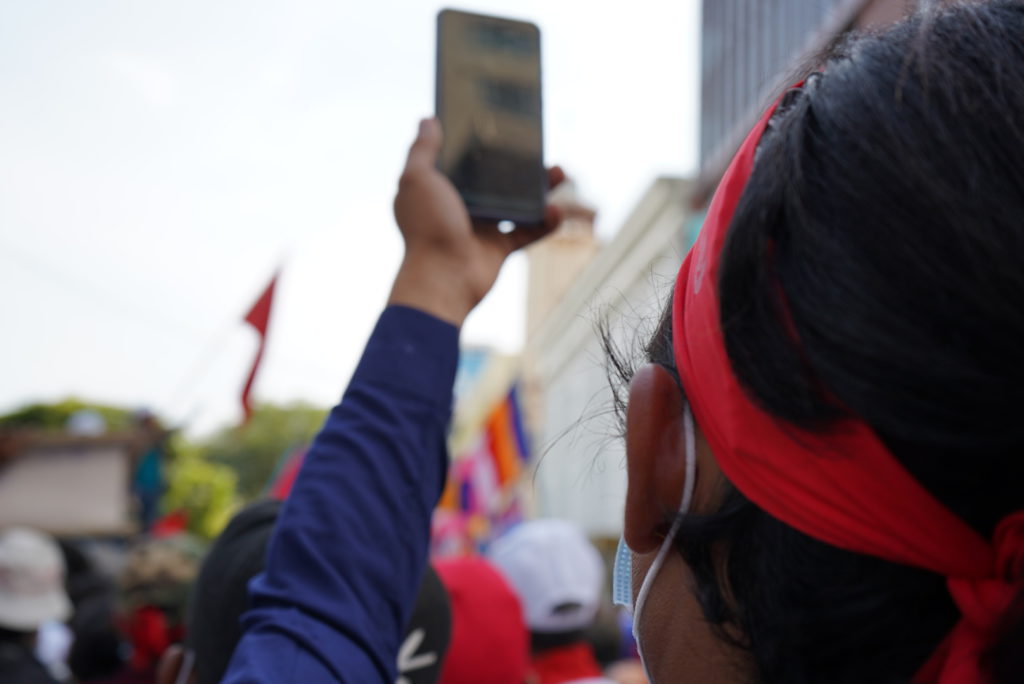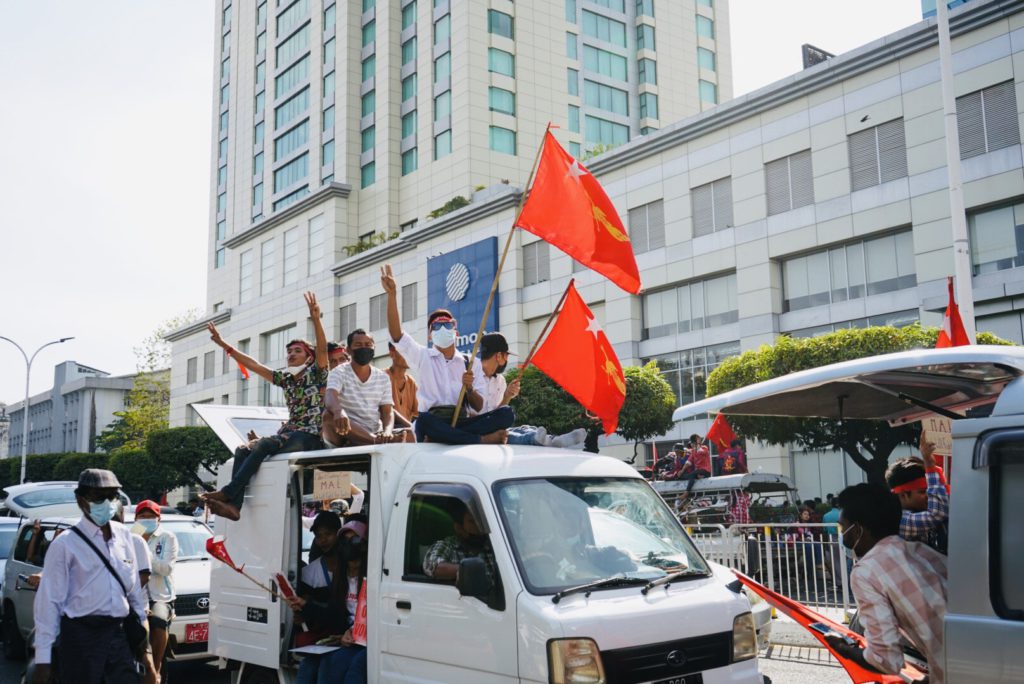It was a seemingly serene Monday morning in downtown Yangon. Trishaw drivers were pedaling along the Anawrahta Road, ferrying women who had finished their shopping at the wet market. Commuters were strolling to work. Street vendors were chanting long lists of items that they were selling. Just one thing was missing—the internet.
Telecom connectivity in Myanmar dropped by 70% at 3:00 a.m. on February 1, recovering to ordinary levels five hours later, according to the internet monitoring service NetBlocks.
Shortly after the disconnection, the military seized control of the government and arrested the country’s de facto leader, Aung San Suu Kyi. President Win Myint, senior civilian officials, and activists were also taken into custody. Three days after the coup, the junta ordered local telecom firms to block Facebook and WhatsApp for “spreading fake news and misinformation.”
In particular, many locals reacted to the military coup on Facebook. A page named Civil Disobedience Movement, which launched on February 2, garnered nearly 280,000 followers within hours. “The movement belongs to everyone against the military coup,” reads its description.
What was meant to be a temporary ban until midnight on February 7 has remained in place. There is no information about when the block on social media platforms will be lifted for users in Myanmar. The military also issued orders to ban Twitter and Instagram “until further notice,” according to a statement published by Norwegian telecom firm Telenor on February 5.
As a result of the restriction, people in Myanmar are navigating new waters and equipping themselves with an array of digital tools to circumvent what some call “digital dictatorship.” Many have installed virtual private networks (VPN) and encrypted messaging apps.
The transition is jarring for some. Here is the crux of the matter: with over 22 million users in a country of about 53 million inhabitants, Facebook was the internet for many people.
“I opened a Facebook account in 2009 while studying in Singapore. This was the time when people in Asia were trying to jump on the social media bandwagon. After coming back to Myanmar in 2011, I would go to an internet cafe to use Facebook. This was when Facebook slowly emerged among those Burmese who lived overseas or had been traveling to other countries,” said Janus Muu, a Yangon-based freelance voice actor and musician.

In 2011, only 1% of Myanmar’s population had access to the internet, while the government controlled all domestic internet service providers, according to a report released by Freedom House in 2012.
Internet penetration rose to 11.5% over the next three years. Then, Myanmar’s government granted Qatari telecom provider Ooredoo and Norway-headquartered Telenor access to the county. The two operators kicked off a mobile revolution by offering low-cost SIMs to people in Myanmar. The affordability and availability of internet access, along with rising internet freedom, made social media platforms a frequent gathering point and avenue to search for information for everyone in the country in the following years.
Facebook quickly became the favored channel for many, thanks in part to Facebook’s Free Basics program, a service that offered users access to a limited selection of websites and services at no cost, without any data charges, in developing countries. Although the initiative was terminated in 2017, it made Facebook the go-to platform in Myanmar.
“Facebook use spread quickly, partly because phones typically came preloaded with Facebook, and some mobile plans did not count time on Facebook toward the plan’s minutes,” cultural anthropologist Christina Fink wrote in an article for the Journal of International Affairs, a publication of Columbia University’s School of International and Public Affairs.
Many users admitted that messaging and browsing Facebook had become “an addiction,” while many also consider the social network the “only entry point” for information, according to a report published by the Groupe Speciale Mobile (GSM) Association in 2015.
Myanmar’s de facto leader Aung San Suu Kyi posted her first post on Facebook in April last year, saying that the channel could help “effectively communicate with citizens.” She had been regularly posting information and a series of videos about the government’s efforts to combat COVID-19 on the network since then. Her last post was on September 7. Her profile is followed by over 2.7 million people.
The platform is also where many small, and big businesses, operate. Family-owned brick-and-mortar shops run Facebook pages to boost sales online, while international phone makers like Oppo and Huawei also use the platform to lure buyers.
Facebook provided Burmese citizens “freedom to obtain information, express themselves, and connect with others,” wrote Fink. However, she added that “posts featuring dangerous speech have become prevalent, contributing to rising anti-Muslim sentiment and tolerance for violence against Muslims.”
Facebook was criticized by the United Nations for playing a a “determining role” in spreading hate speech that fueled the mass expulsion of Rohingya in Myanmar’s Rakhine state in August 2017 as well as the death of thousands of Rohingya, according to findings released by the UN Human Rights Council.
The social media giant responded with a formal written apology in November 2018, and promised to work towards limiting the spread of fake news and hate speech online before the general election in November last year. The platform also set up an Oversight Board to review its content, yet, that didn’t save the social media network to fall under the radar of the military’s new government.
In a statement released on February 11 by Facebook, the US-based firm wrote that “the situation on the ground remains volatile and Facebook is adapting to meet these events.” The platform has also suspended the ability for Myanmar government agencies to send content removal requests through normal channels reserved for authorities around the world.
Abruptly unplugged
The internet shutdown and social media ban have left many in Myanmar scrambling at a time of major uncertainty.
Muu normally leverages the social media platform to connect with his 6,000 followers and promote his music. “I could still remember how bad the day was when the government blocked internet access on February 1. We never thought that the internet ban could ever happen. People started to text and call their friends again, it makes me feel like we are going back to 2008, when the internet was a luxury for many people in the country,” he said.
Panic in the country is reflected by the surge in VPN downloads, which rose by 7,200% shortly after the social media ban on February 4, according to data from independent research group Top10VPN. Offline messaging app Bridgefy, which operates on a mesh network so users can communicate via Bluetooth—no cellular or data network needed—was downloaded over 1 million times in Myanmar, according to the company.
“I was shocked. After the coup happened, I became more active than ever on Facebook. Despite the social media ban, many people, including myself, have flocked to download VPN services. Sometimes, I will shoot out ten posts on Facebook every 20 minutes if needed for urgent news,” 27-year-old tech business entrepreneur and restaurant owner, who preferred to use the alias Pho Thaw, told KrASIA. He has reshared information in support of the Civil Disobedience Movement Facebook page.
Today, Myanmar experience the tenth night of internet blackouts since February 15, according to internet monitoring service NetBlocks. The new normal is an ongoing internet blackout, a social media ban, and tightening online censorship. Young people have adjusted, but an elder generation that was glued to Facebook is now in limbo.
“The day when the internet shut down, my aunty and grand aunt felt very uneasy and kept scrolling the screen. She asked me if the internet would come back again,” Muu said. “I spent a lot of time explaining why the internet was disconnected. However, they are still confused about the internet gag, the only thing they could do is to keep refreshing the Facebook app. However, all the effort is in vain.”
The future of the digital landscape remains gloomy, as the military regime continues to tighten its grip on the web. It has pushed forward a draconian cybersecurity law, which grants authorities access to all the information and data of individual users upon request, even without stated reason or warrant.

The bill could take Myanmar back to “the stone age,” an industry veteran who spoke under the condition of anonymity told KrASIA.
Pho Thaw feels this panorama of internet censorship and control someway familiar, yet, he is afraid of revisiting the past. “In early 2000, the whole internet was monitored and filtered by the authority. The internet speed was extremely slow. When my school teacher opened a web page, we would all play card games to wait for the refresh. I wasn’t truly aware that I was living in a self-contained cyberspace,” said the 27-year-old.
“In 2006, I gained access to the internet for the very first time, but so many websites were banned at the time, including Google and YouTube. As Gmail was blocked in the country, I had to purchase an email account through one of the two internet service providers available in the country. I could still remember the domain name—‘mailforyou.com.mm’, which sounds like the address of some spam mail,” he said.
Now, with four devices all connected to Facebook through VPNs, the 27-year-old was annoyed by the constant influx of confirmation messages: “Log-in activity from Germany was detected. Was it you?” Despite the ban, he remains active, and occasionally shares information about new protest initiatives.
He is concerned about his personal safety. “I always post the latest information on the situation of Myanmar. The government is probably looking at the people who are popular on social media and occupy a lot of internet traffic. If they make arrests in my neighborhood, I don’t know what to do. We are compelled to adapt and are not sure what the future will hold.”
This article is part of KrASIA’s “Tech in Culture” series, where the writers of KrASIA unpack how tech is changing the status quo across Asia.

